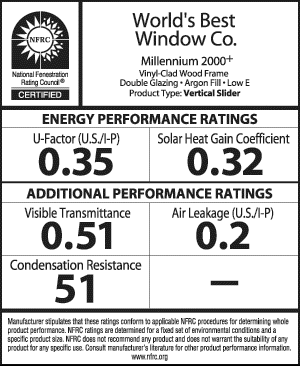 If you’re considering new windows for your home, you’ve likely seen the sticker on new or replacement windows you’ve looked at. The great thing about the window industry is that it is highly regulated and those window stickers aren’t something that the manufacturer determines. An independent third party, called the National Fenestration Rating Council (NFRC), sets the ratings. The Efficient Windows Collaborative™ sets the recommendations for the US for different regions. This will help you compare windows in an apples to apples manner. If your primary purpose for your new windows is to improve your home’s comfort and energy efficiency, you need to understand these abbreviations.
If you’re considering new windows for your home, you’ve likely seen the sticker on new or replacement windows you’ve looked at. The great thing about the window industry is that it is highly regulated and those window stickers aren’t something that the manufacturer determines. An independent third party, called the National Fenestration Rating Council (NFRC), sets the ratings. The Efficient Windows Collaborative™ sets the recommendations for the US for different regions. This will help you compare windows in an apples to apples manner. If your primary purpose for your new windows is to improve your home’s comfort and energy efficiency, you need to understand these abbreviations.
U-Factor
This is the window’s rating for heat flow resistance, meaning, how insulating the window is. When looking at the number, it’s always going to be a decimal as the ratings go from 0 – 1. The more insulative a window is, the lower the number. ENERGY STAR® and the Efficient Windows Collaborative™ recommend homes in Indianapolis and most of Indiana have a U-factor of .25 or less.
SHGC
Solar Heat Gain Coefficient is meant to help you understand how the sun’s rays may become heat inside your home. Like U-Factor, it’s a 0 – 1 scale where the lower the number, the less solar heat gain your home will experience. Unlike some southern climates where they always want a low number, you must factor in your specific home and goals. If your home has trees shading it in the summer, you may want to take advantage of the sun’s rays in the winter to help warm your home and choose a window with a higher SHGC such as .35-.6. If you don’t, choose a window with a SHGC below .32.
VT
This is a matter of personal preference. If you want a light and bright home, you want a window with a higher VT number. Again, you’re looking at a range of 0 – 1. Things that influence the Visible Transmittance of a window are the number of panes, tinting, glazing, and fill.
AL
Air leakage recommendations don’t vary by region. This is the measurement of the amount of air moving around a window. The Efficient Windows Collaborative recommends only choosing a window with a AL of .30 or less.
Choosing new or replacement windows for your home doesn’t have to be confusing. The professionals at Blair Windows & Doors will answer your questions and guide you to the best window for your home, budget, and goals. Call 317-356-4666 for your no obligation in-home estimate today.
